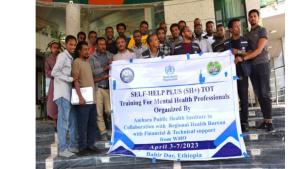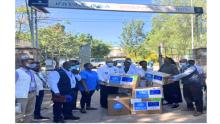Scaling up mental health and psychosocial support in conflict settings
Case study: Northern Ethiopia
Context:
Conflict broke out in Northern Ethiopia in November 2020 between the Tigray People’s Liberation Forces (TPLF) and the Ethiopian National Army. Violence escalated in June 2021, spreading to Afar and Amhara regions by September 2021. In addition, a prolonged drought following five consecutive poor rainy seasons negatively impacted 13 million people in seven of the country’s 13 regions. Overall, by March 2023, there were an estimated 22.6 million people in need of humanitarian assistance. A total of 17.4 million people needed emergency life-saving health interventions and the targeted population in the Ethiopia Humanitarian Response Plan 2023 was 9.8 million.
Between January and July 2023, violence in Tigray, Afar, Amhara and Somalia de-escalated, although it continues in Oromia. The conflict severely disrupted all social services, including health, and incidence of gender-based violence (GBV) was high. As shown in Table 1 below, the expressed need for mental health and psychosocial services (MHPSS) was high, with limited capacity to deliver services. There was a shortage of mental health essential medicines as no deliveries had taken place for up to two years in conflict-affected communities.
|
Population in Need |
Region |
WHO targeted population (30% of total) |
|||
|
Afar |
Amhara |
Tigray |
Total |
||
|
People in need of MHPSS |
355 037 |
1 632 674 |
1 262 557 |
3 250 268 |
975 081 |
|
People in need of focused mental health care (people with severe mental disorders) |
80 690 |
371 062 |
286 945 |
738 697 |
221 609 |
Table 1: The estimated population in need of mental health and psychosocial support (MHPSS) by region in Northern Ethiopia (Source: estimates are based on Ethiopia HRP 2023)
To respond to the mental and psychosocial health needs of the affected population, the Ministry of Health developed and implemented a strategic plan, while strengthening coordination and multisectoral collaboration. These efforts resulted in a streamlined and improved relationship between the National Institute of Public Health and the Ministry of Health Mental Health Programme at the national level, ensuring participatory planning with clear roles and responsibilities, and aligning partners’ resources and interventions to the agreed plans.
All regions reported an increase in the number of people accessing health services. Active community support and functional multisectoral approaches improved the identification and mitigation of attempted suicide. The Ministry of Health requested WHO to support the implementation of the strategic plan.
Key achievements:
To support the Ministry of Health in strengthening governance and leadership at the national and regional levels, WHO deployed technical officers to affected regions and one MHPPS national professional officer to the WHO Country Office. National and regional MHPSS Technical Working Groups (TWGs) were established and trained and met at least once a week. The TWG at the national level strengthened the relationship between the National Institute of Public Health and the Ministry of Health’s Mental Health Programme. At the regional level, TWGs brought partners together to plan and coordinate the delivery of health services. A mapping exercise was done to show which partners were doing what, where and when, and roles and responsibilities were agreed upon.
“A partner like WHO that had medication provided medicines for the public health facilities, as well as for partners which had the specialist mental health personnel, but not the medications due to procurement and import difficulties,” explains Marjorie Mupandare, the Northern Ethiopia response Incident Manager. Referral pathways were also established, both horizontally and vertically, in the health care system.
The Ministry of Health, with support from WHO, improved capacity to provide MHPSS through training of health workers in affected regions, and the adaptation and dissemination of WHO materials. By March 2023, a total of 2750 Mental Health Gap Action Programme (MhGAP) Humanitarian Implementation Guide (HIG) and Implementation Guide manuals (IG) had been procured and distributed in the three regions, and a total of 1230 general health care workers trained in mhGAP.
The MhGAP training was carried out in combination with gender-based violence training as well as self-care sessions. At the request of the Ministry of Health, WHO led the contextualization, translation and rollout of Self Help Plus, a non-pharmacological, structured psychosocial intervention that can be delivered in groups. In April 2023, 52 healthcare workers were trained on Self Help Plus as trainers of lay people, who then facilitated group sessions in affected regions.
MHPSS was integrated into the delivery of routine essential health services by the Mobile Health and Nutrition Teams (MHNTs) and health facilities. WHO supported the Ministry of Health to train health workers within the MHNTs and health facilities on MHPSS, while partners were supported to integrate mental health specialists within their MHNTs. WHO assisted the Ministry of Health to procure and distribute essential psychotropic medicines to all hospitals and priority health centres in the three affected regions. Key partners and the St Amanuel National Referral Mental Hospital also received medications.
Reflecting the importance of the supplies, Acting Medical Director of St Amanuel Hospital, Dr Kibrom Hagos, says: “I want to say thank you on behalf of the patients for your quick response. Our supplies had completely run out and we had no hope.” The medications were supplied between March and May 2023 and will serve 576 800 patients for the next six months.
As a result, the three regions consistently reported an increasing trend in the numbers of people accessing mental health services over the five-month period, January to May 2023. (Figure 1)
Source: DHIS reports from seven hospitals in the Afar region, DHIS reports from seven conflict affected zones of the Amhara region and manual handwritten Reports from nine hospitals in the Tigray region. Obtained 10 June 2023.
An increasing number of cases of attempted suicide and suicide were also identified in the Amhara region. Key multi-sectoral stakeholders at the national and regional level were engaged and supported in February 2023 to carry out suicide prevention activities. Similar interventions were implemented following a suicide in an Internally Displaced Persons Camp in Mekhoni, in the Tigray region, in March 2023.
With technical support from WHO, regular multi-sectoral Intra-Action Review meetings were held to identify what was working well, as well as the challenges and gaps in services. An action plan was developed, including having funds immediately allocated to ensure that activities were promptly implemented at the regional and federal levels and involving the protection and education clusters. Further, the MHPSS team supported the response to the refugees and returnees from Sudan by coordinating MHPSS and GBV interventions, at the regional level, for the worst affected regions. Teams deployed by partners were trained, while case management was supported at Matema General Hospital, along with referrals to Gonda Teaching Hospital.
The success story of MHPSS interventions in conflict-affected Northern Ethiopia would not have been possible without funding from European Union, Central Emergency Response Fund (CERF) and United States Agency for International Development. The collaboration between WHO and the Ministry of Health, including the Ethiopia Public Health Institute, the regional health bureaus and partners, ensured seamless implementation.
For technical information
Dr Medhin Selamu
Migration and MHPSS Officer
selamum [at] who.int

